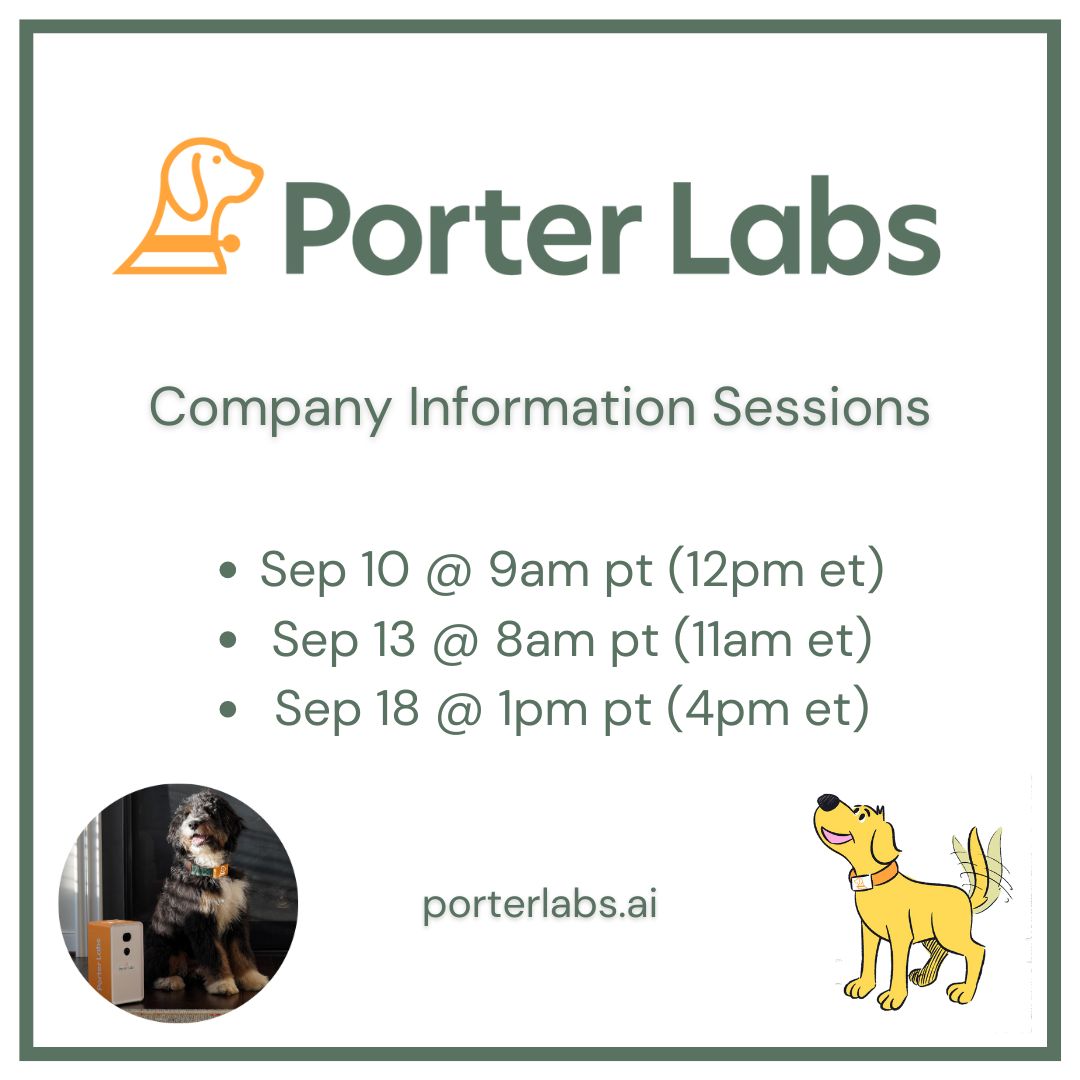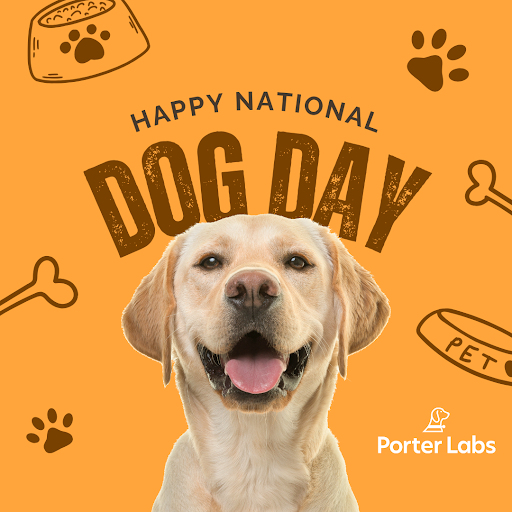Artificial intelligence (AI) is no longer science fiction; it’s unleashing a wave of innovation across almost every industry, including dog training and behavior. From smart collars that are getting better and better at monitoring a dog’s activity and health, to customized dog training and in-depth behavior analysis, AI is transforming the way we interact with our canine companions.
At Porter Labs, we’re excited and inspired by the possibilities! We’re applying our extensive knowledge in software and network engineering to provide dog owners with our next-generation dog training and enrichment product, PupStation, which utilizes expertly curated data to help you and your dog live your best life together.
Nonetheless, we understand why some pet parents might be skeptical of new AI-based products, given the proliferation of online discussion about AI and the conflicting perception of AI as either a miracle solution or a sometimes-unreliable technology.
We’d like to point out a crucial distinction to consider for pet owners seeking answers about their dog’s well-being: the source and quality of the AI’s data. Let’s explore the nuances of data quality in AI and how Porter Labs is committed to harnessing high-quality data to revolutionize dog health and training!
Navigating data quality in AI
When it comes to artificial intelligence (AI) for dog behavior assessment and training, data quality is key. You’ve probably encountered many different AI tools in both your personal and professional life, from publicly accessible chatbots like ChatGPT, to the recent addition of the ‘AI Overview’ you’ll find at the top of Google search results. AI is becoming so thoroughly entrenched in our online lives that its presence is often imperceptible, seamlessly integrated into our everyday interactions and decision-making processes.This makes it increasingly important to understand the differences in data quality, and the pros and cons of each.
Here are some ways that AI data sources vary:
- Uncurated data: Some AI tools aggregate information from the vast expanse of the Internet without any human oversight of where the information comes from. This can lead to interesting, but potentially inaccurate, insights. However, it can also inspire creativity, for example in art and music, by drawing inspiration from diverse sources.
- Data from curated sources: Using humans to curate data sources allows AI tools—like the popular chatbots ChatGPT and Gemini, etc.—to offer more reliable insights by prioritizing information from credible sources. However, despite aiming for accuracy, variations in data quality may still occur, given the vast amount of data they are processing. These tools offer rapid access to information that would otherwise require hours, days, or even weeks to research. However, users bear the responsibility of verifying these answers before sharing or acting on them, especially for inquiries about the health or behavior of people or animals.
- Expertly curated data: Some emerging AI tools for pet health and behavior information are highly specialized. Therefore they must utilize meticulously selected data from trusted sources such as veterinary research and behavioral studies. These tools can ensure high accuracy and reliability by relying on data that has been rigorously vetted by human experts.
Should you be concerned about the data source when using AI for your dog’s health or behavior? Absolutely. There are advantages and disadvantages to each approach, but for trustworthy dog health and training advice, a tool using expertly curated data is the best possible choice.
Examples of expertly curated data in animal health and behavior
What exactly do we mean by expertly curated data? To provide insight into how data is assembled and verified to provide highly accurate decision-making about pet health, here are a few examples:
- AskVet, a pioneer in veterinary telehealth, introduced VERA (Veterinary Engagement and Relationship Agent), the world’s first AI-driven digital veterinarian. Trained on meticulously curated data sets, including two million recorded veterinarian-animal owner conversations, six veterinary college curricula, and 180 veterinarian-reviewed data sets from trusted industry sources, VERA addresses the increasing demand for veterinary expertise in the companion and food animal industries, bridging the gap between limited availability of veterinarians and growing demand.
- RenalTech, developed by Mars Petcare, uses artificial intelligence to analyze pet medical record data to predict whether a cat will develop chronic kidney disease (CKD) up to two years before traditional clinical diagnosis.
- IDEXX DecisionIQ uses patient-specific data plus a collection of veterinary knowledge, diagnostic algorithms, veterinary consensus statements, peer-reviewed publications, and textbooks, plus IDEXX’s 40 years of proprietary research, to identify patterns in diagnostic testing that could indicate current or developing diseases.
This type of data is specifically designed to address the unique needs and challenges of animal health and behavior, including diagnosing illnesses, providing treatment recommendations, and offering behavioral advice. These data sets undergo rigorous vetting and review by veterinary and behavior experts to ensure its quality and relevance. These AI tools, and others like them, are trained with curated data obtained through trusted resources and experts. For example:
- Professional journals: Peer-reviewed research papers provide a reliable source of scientifically validated information.
- Clinical trial data: Data from controlled clinical trials offers a wealth of insights into specific medical conditions and treatment efficacy.
- Expert annotations: Data annotated by medical professionals adds crucial context and ensures accurate interpretation by the AI model.
Drawbacks to expertly curated data
Access to these and other specialized AI tools and the databases that support them are usually restricted to veterinary professionals or by a paid subscription. Not all professional journals are digitized, although more are being added online, and clinical trial data as well as pet owner conversations are usually privacy protected. However, pet owners can reap the benefits of this trusted data through professionals and businesses who invest in and utilize it in approved ways:
- Pet businesses, like Porter Labs, can invest to access expertly curated data, which can power pet activity, health, and training tools that would be available directly to pet parents.
- Your own veterinarian or veterinary behaviorist will have more access to AI tools that utilize curated data specific to their profession, improving their ability to diagnose and treat your pet!
As we continue to develop dog training and play tools for pet parents at Porter Labs, we are committed to using data that has been collected and vetted by animal behavior and veterinary experts, to create products that pet owners can trust with the behavior assessment, training, and mental wellbeing of their dog.
Should pet parents use chatbots for pet information?
So what about ChatGPT and other chatbots that are right there at your fingertips? If your dog suddenly starts pacing anxiously back and forth, why wouldn’t you jump online and ask them why this might be happening?
Let look briefly at how chatbots work:
Basically, a chatbot is any helpful text box that asks “can I help you?” and is not staffed by an actual living human. They range from a simple text box that pops up to offer help when you visit a website, to conversational, generative AI chatbots that can be used to create new content or preliminarily research answers to questions, like ChatGPT, Gemini, and others.
- Rule-based chatbots provide consistent answers to simple questions based on predefined rules. If you ask something they haven’t been programmed to answer, they are stumped, and will direct you to a live representative for complex inquiries. You’ve no doubt encountered them during online shopping or banking.
- ‘Conversational AI’ chatbots use natural language processing (NLP) to actively assess your questions. These AI tools, like ChatGPT, utilize machine learning algorithms to analyze the meaning of your words and the conversation’s context, and respond with answers. They are far more flexible than rule-based chatbots, and need access to a massive pool of data to provide you with the answers you are looking for.
Where do chatbots like ChatGPT get their answers?
AI conversational tools are trained on massive datasets of text and code that come from a variety of sources, including but not limited to:
- Digitized books: Millions of books across various genres and topics
- Articles: News articles, research papers, and blog posts
- Websites: Online content from a variety of sources, such as personal blogs, professional websites, and online forums
- Academic research papers: Scientific research findings published online in scholarly journals and articles
- Code repositories: Platforms like GitHub – a cloud-based platform where software developers store, manage, and collaborate on code
- Public dialogue: Public conversation archives, including social media and transcripts of spoken conversations
What are the benefits of conversational AI chatbots?
ChatGPT and other conversational AI chatbots can power through a huge amount of data far more quickly than a pet owner, or even a professional.
- They are publicly accessible: Free versions of Gemini and ChatGPT are available 24/7, empowering pet owners to research their dog’s health and behavior independently, reducing anxiety and prompting them to contact their veterinarian earlier for help.
- Hidden data is quickly revealed: Due to the sheer volume of data these AI tools can tap, patterns and correlations mere human minds might miss may be revealed, potentially providing pet parents with pet health and behavior information that they might never have come across by simply putting keywords into a standard search engine and checking ranked websites one by one.
- They provide pet owners with a starting point: Conversational AI tools can empower pet owners by providing a starting point for research and helping them connect health terminology to potential health issues. This newfound knowledge can lead to more effective communication with veterinarians and trainers.
The cons to conversational AI
The very features that make data aggregation attractive also bring significant challenges:
- Data quality: The internet is full of misinformation and anecdotal evidence, which can easily be included in the AI’s info base. This can lead to inaccurate or misleading recommendations for pet owners.
- Limited veterinary data: Public AI tools lack access to some of the extensive veterinary information in private databases.
- Bias and incompleteness: AI algorithms trained on biased data can perpetuate knowledge gaps and myths about certain dog breeds, genetic predispositions, training methods, etc.
- Misinterpretation: Without professional guidance, pet owners might misinterpret AI-generated information, leading them to attempt self-treatment that could have harmful consequences for their dog.
- Algorithms can inadvertently create a ‘filter bubble:’ By prioritizing information you have already interacted with or asked about, algorithms may create a filter bubble that limits your exposure to diverse viewpoints on pet health. As an example, you’ve probably noticed that your social media feed shows mostly topics and friends you commonly interact with, leaving you in the dark about other friends or uncommon topics. This is a filter bubble in action.
- The authoritative tone can dampen skepticism: AI tools are trained to provide conversational answers that sound reasonable and authoritative. You can also specifically request a more friendly or professional tone in your question prompts. It’s difficult to maintain healthy skepticism when the answers you receive are comforting and convincing.
The ability to tap vast amounts of raw public data via chatbots like ChatGPT is powerful and fascinating, however it carries with it a heightened responsibility on the user to carefully verify results before using or sharing it.
Should pet parents avoid using ChatGPT to answer questions?
When it comes to the wellbeing of your pets – who are beloved family members – of course you will utilize whatever tools are available to you, especially when they can provide helpful information!
Even experts use ChatGPT as a “second eye” – but they also verify the information they find.
We suggest that pet owners consider AI-generated answers as if they were coming from a knowledgeable, but non-expert, friend. Always verify with a veterinarian, behaviorist, or trainer before acting on non-expert AI-generated advice that could impact your pet’s health or wellbeing.
Different types of AI data can work together, responsibly
As AI continues to evolve within human and animal wellness, a hybrid approach to data accuracy is the most effective strategy.
Publicly available chatbots can be used by pet parents to guide consultation with their veterinarian, behaviorist, or dog trainer.
Expertly curated data is then used to build advanced AI tools that support both professionals and pet parents in direct and specific care of a pet’s health and behavior.
In short, AI tools using expertly curated data are specialists with deep knowledge in a specific area.
Porter Labs is excited to be part of your AI journey
AI offers exciting possibilities for dog health, behavior, and training. Data that pet parents can trust is key. At Porter Labs, we are committed to referencing expertly curated data and will collaborate with veterinary and behavior professionals to ensure our AI tools empower—not mislead or replace—pet owners. We’re building a future where AI enhances canine well-being and the human-animal bond.
Want to stay on the cutting edge of AI in the pet space?




